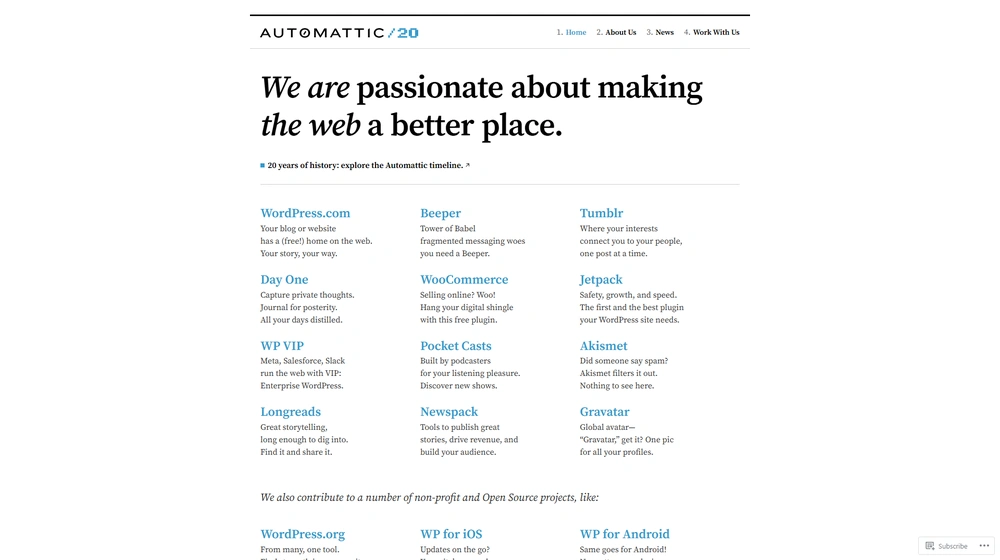Automattic’s WordPress.com platform has evolved into a full-service SaaS suite for entrepreneurs, SMB owners, and digital creators seeking robust yet low-maintenance web presence, ecommerce, and content tools. In this 2025 review, you’ll get a factual, in-depth look at its product strategy, features, pricing, and where Automattic stands out in a crowded SaaS market.
From Launch to 2025: Automattic’s WordPress.com Evolution
- 2005–2010: WordPress.com launches, pioneering simplified blog and website hosting for millions, powered by open-source WordPress.
- 2013: SaaS plans expand to include domains, themes, and early ecommerce, targeting side hustlers and emerging businesses.
- 2018–2022: AI-powered design tools, improved onboarding, REST APIs, and transactional commerce roll out. Competitors like Wix, Squarespace, and Shopify mount challenges.
- 2024: WordPress.com repositions as an all-in-one business website platform, featuring unmetered traffic, real-time backups, enterprise-grade DDoS and hack recovery, and seamless integrations.
- 2025: Automattic leverages deep WordPress core contributions to offer an extensible SaaS platform serving creators and enterprises—from freelancers to Fortune 500.

Key Features: Platform Capabilities
- No-Code Website Builder: Drag-and-drop page editing supported by block-based themes and zero technical setup. Launch blogs, portfolios, or storefronts easily.
- Managed Hosting: Unmetered bandwidth, global CDN, daily backups, hack recovery, and DDoS protection. Performance is enterprise-grade from day one.
- Domain Management: Register, manage, and point domains directly, with support for .com, .org, .net, and many others. Domain-only buying supported.
- Commerce Ready: Native store functionality, digital/physical sales, payment integration, and newsletter tools built-in. Supports global currencies and merchant requirements.
- AI & Automation: AI-powered website generation, theme personalization, and content suggestions help users launch and optimize sites faster.
- Developer-Friendly: Pro dev tools, SFTP, SSH, API integrations, and plugin/theme extensibility (on applicable tiers). Support for multi-site and custom workflows.
- Enterprise & Agency: Advanced offerings through WordPress VIP and Studio for high-traffic, mission-critical sites—SLAs and compliance ready.
Workflow & User Experience
- Unified dashboard for site, email, commerce, and content management.
- Assisted onboarding: AI builder jump-starts design, domain, and content.
- Flexible block editor: drag patterns or compose from scratch.
- Role-based access for team and client collaboration.
- Mobile-optimized management with dedicated Jetpack app support.
- Upgrade path: start with basic tools, scale to advanced workflows or agency/enterprise plans without site migration.
Automattic WordPress.com Pricing
| Plan | Best For | Key Features | Annual Pricing |
|---|---|---|---|
| Free | Personal/Trial | Basic website, hosted domain (wp.com), limited storage | $0 |
| Starter | Personal, Hobby, Portfolios | Custom domain, simple themes, basic analytics | ~$48/year |
| Explorer | Growing blogs | Monetization, advanced themes, premium support | ~$96/year |
| Creator | Business, Ecommerce | Online payments, advanced plugins, email, SEO | ~$300/year |
| Entrepreneur | Scalable business/web store | Priority support, advanced dev tools, marketing suite | ~$540/year |
| VIP | Enterprise, Agency | Dedicated support, SLAs, global edge CDN, compliance | Custom/Quote (starts ~$25,000/year) |
How Automattic Compares (2025)
| Feature | Automattic (WordPress.com) | Wix | Squarespace | Shopify |
|---|---|---|---|---|
| Open Source Core | Yes, extensible | No | No | No |
| Managed Hosting | Yes, unmetered | Yes, capped | Yes, capped | Yes, commerce optimized |
| AI Website Builder | Yes | Yes | Limited | Yes (Store) |
| Plugin/Theme Extensibility | Full (on higher tiers) | Limited | Themes+inject | Apps, proprietary |
| Ecommerce Integration | Native & WooCommerce | Native, fewer features | Basic store | Advanced (core feature) |
| Dev Tools & API | SSH, SFTP, REST | No | No | Limited |
| Support Model | Email, chat, onboarding. SLAs on VIP | Email/Chat, paid phone | Email, paid phone/chat | Chat, email, paid help |
| Domain/Email | Yes, integrated | Yes, integrated | Yes, integrated | Limited/3rd party |
| Best for | SMBs, creators, agencies | DIY, small business | Design, portfolio, simple store | Ecommerce-first |
Pro Tip: For scaling teams or agencies, the jump from Creator to VIP unlocks direct access to Automattic engineers, compliance, and advanced developer features that no other website SaaS (even Shopify or Squarespace) matches. Start with Creator, then assess your traffic and SLA needs before upgrading to VIP.
Integrations
- WooCommerce (native for advanced stores and third-party plugins)
- Mail, newsletter, and marketing tools
- REST API for custom apps
- Zapier, code-free workflows via plugin library
- Google Apps and Analytics
- Stripe, PayPal, and common payment processors
Pros & Cons
| Pros | Cons |
|---|---|
|
|
Final Thoughts: Should You Choose Automattic in 2025?
For entrepreneurs and SMBs seeking long-term growth on a trusted, extensible web platform, Automattic’s WordPress.com remains unrivaled for flexibility and peace of mind. Its blend of managed hosting, AI enhancements, and open ecosystem delivers enterprise reliability at SMB prices. If you value control, the ability to scale, or open integration—without hiring an IT team—Automattic is on a shortlist worth serious consideration in 2025.
Automattic FAQ
Yes, it meets GDPR standards and supports HIPAA via a signed BAA on eligible plans.
Yes, white-label portals support your domain, favicon, and brand visuals.
Ideal for consultants, service firms, and SMBs needing streamlined collaboration.
No—integrates with both. Stripe powers payments; QuickBooks handles accounting.
All plans include chat/email; premium tiers add onboarding and 1:1 setup help.
This post may contain affiliate links and we may earn commissions. Learn more in our disclosure.

